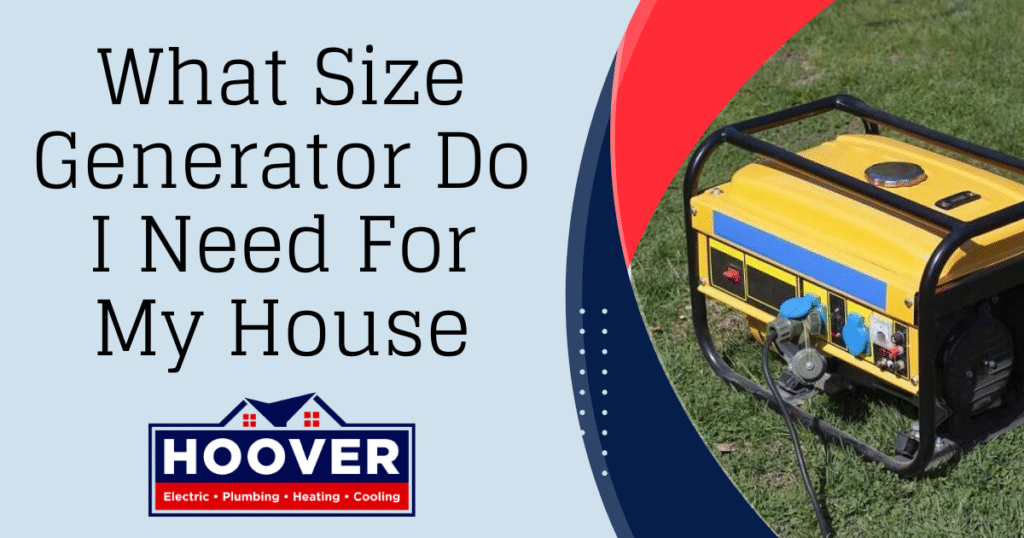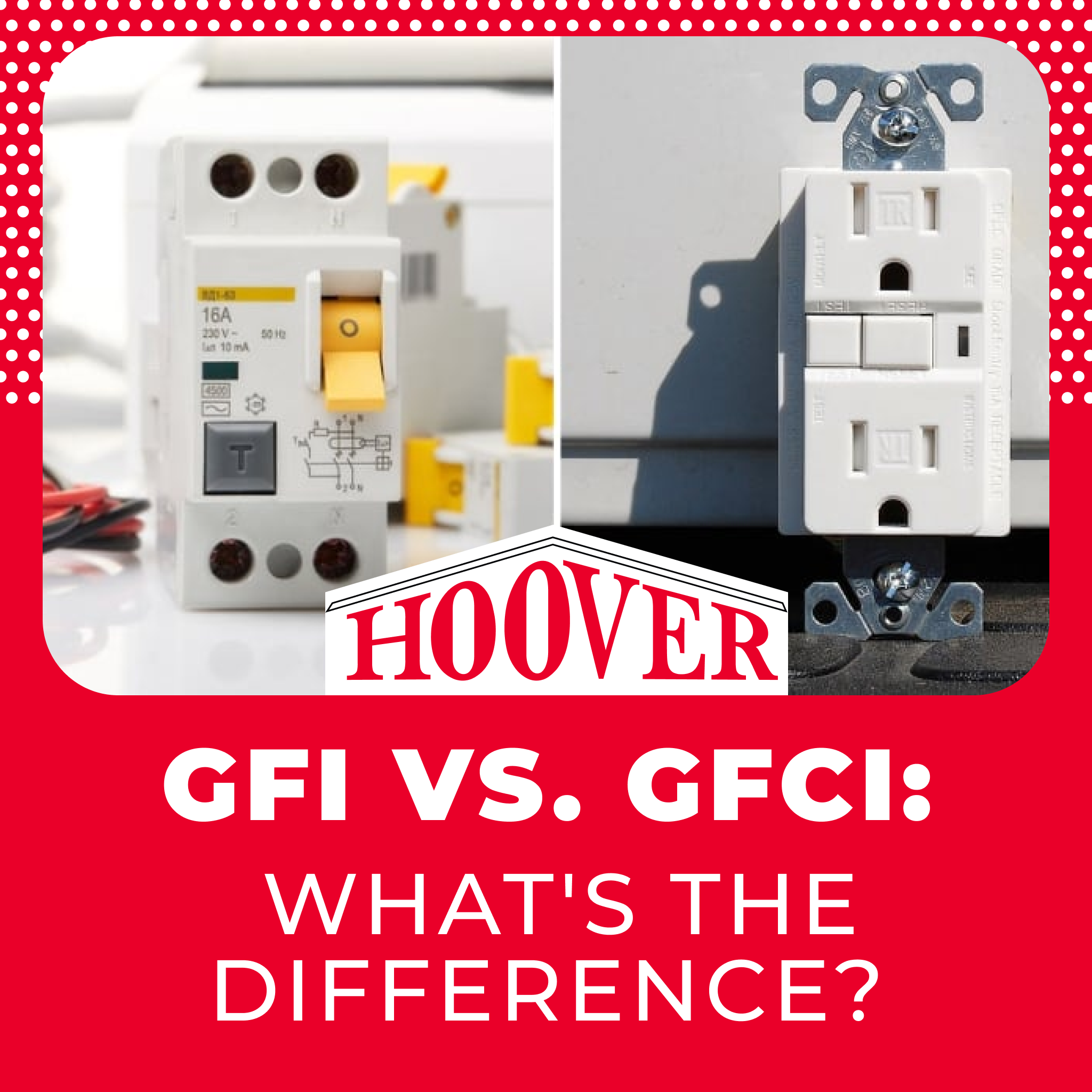
Key Takeaways:
- Generator size should match your total power needs during an outage, including starting wattage.
- A typical home needs a generator that can handle between 5,000 and 20,000 watts, depending on the size and appliances.
- A licensed electrician can calculate your home’s electrical load accurately.
Choosing the right generator keeps the lights and essential appliances on during an outage. Proper sizing depends on your home’s electrical load and other factors. Learn what size generator you need for your house with guidance from Hoover on total wattage, system types, and step-by-step calculations.
How Do I Determine the Right Size Generator for My Home?
The right generator size depends on how much electricity your household needs during a power outage. Most single-family homes fall within the 5,000 to 25,000-watt range, depending on size, systems, and household needs. To calculate approximate generator needs, consider the appliances and devices you need during an outage and add their wattages.
Home generator sizing involves more than basic math, though. To avoid misjudging your needs, consult a qualified electrician for a detailed load analysis and recommendation.
Why Generator Size Matters: Safety, Cost & Comfort
Generator sizing affects how safely and effectively your backup power system runs. An undersized unit won’t support essential equipment, such as your refrigerator or HVAC system, and may shut down under load. Overloaded systems can overheat and pose fire risks.
Larger systems require more fuel and cost more to install and maintain, and an oversized unit may waste fuel if it’s rarely used at full output. By matching generator capacity to actual usage, you improve fuel efficiency, reduce wear on the unit, and power your devices and appliances, when the electricity goes out.
What Will You Power During an Outage?
Households often have different varying definitions of essential appliances and devices. People who work from home, for example, may need power for laptops, chargers, and Wi-Fi routers and modems. Those who rely on medical devices, such as ventilators, oxygen concentrators, or CPAP machines, may likewise need additional wattage.
Here are some of the most commonly prioritized items during a blackout and their typical running wattage:
- Refrigerator/freezer: 700 watts
- Sump pump: 1,000 watts
- Gas furnace blower: 800 watts
- LED lightbulb: 7 watts per bulb
- Laptop: 100 watts
- Central AC: 1,000 to 4,000 watts
- Wi-Fi router and modem: 30 to 100 watts
- Medical equipment: 30 to 600 watts depending on the device
Full-home vs. partial-home backup
A whole-home generator powers all circuits in your house, from HVAC systems to kitchen appliances. Most home-use standby generators are rated between 15,000 and 20,000 watts and can handle general household electricity needs. This option is more expensive but offers reliable and comprehensive coverage.
Partial-home generators supply selected circuits, usually focused on essentials. This is a cost-effective option if you only need partial backup, typically between 5,000 and 10,000 watts, without investing in a larger standby system.
What Size Generator Do I Need to Run My Whole House?
For full-house backup, generator size often depends on the square footage. Electrical loads typically correlate with square footage, with larger homes having more appliances and devices and therefore bigger electrical loads. While each home is unique, these wattage estimates provide general guidance:
- 1,500 square feet: 10,000 to 15,000 watts
- 2,000 square feet: 16,000 to 20,000 watts
- 2,500 square feet: 18,000 to 22,000 watts
- 3,000+ square feet: 23,000 to 36,000+ watts
Since household electrical loads vary widely, a professional load assessment is the most reliable way to size a whole-house generator accurately.
How Do I Calculate My Total Wattage Needs?
Estimate your portable or whole-home generator size by calculating the total wattage needed for your chosen appliances. Follow these steps:
- Step 1: List the appliances and devices you need to run.
- Step 2: Note the running wattage for each item, usually found on the appliance label or user manual.
- Step 3: Account for starting watts for motor-driven appliances, which is the power required to start operation.
- Step 4: Add up the running watts, then add the highest starting wattage from an appliance. For example, if your running wattage is 10,000 and the highest start wattage is 1,000, your minimum generator capacity is 11,000.
- Step 5: Add a safety margin, typically 10% to 20%, to cover surges or fluctuations.
Portable vs. Standby Generator: Which One is Right for Me?
Portable and standby generators both offer backup power, but they differ in capacity, automation, and best use. Choosing between them depends on your specific needs.
Portable generators
Portable generators are mobile units that run on gas or propane. They’re a good fit for temporary outages or essential appliances. They offer less power than standby generators, typically between 3,000 and 8,000 watts, and they require manual operation, but they come at a lower price point.
Standby generators
Standby generators are permanent installations that activate automatically when a power outage occurs. They run on natural gas or propane and are wired into your home’s electrical system.
These systems provide higher wattage and can support full-home operation, including HVAC systems and high-demand appliances. Although the upfront cost is higher, they offer convenient automation to prevent power loss to sump pumps, refrigerators, and other important equipment.
Benefits of Professional Generator Sizing and Installation
Basic calculations provide a rough home generator sizing estimate, but working with a licensed electrician offers optimal accuracy and safety. Electricians know how to size a generator according to your home’s needs, and professional generator sizing and installation comes with these benefits:
- Accurate electrical load calculation.
- Safe electrical integration with transfer switches.
- Long-term support and maintenance plans.
- Electrical code compliance.
Service Area – Generator Installation & Sizing Help Near You
Hoover Electric, Plumbing, Heating, and Cooling proudly serves homeowners in Southeast Michigan communities, including:
- Auburn Hills
- Clinton Township
- Ferndale
- Fraser
- Garden City
- Lake Orion
- Pleasant Ridge
- Rochester
- Royal Oak
- Troy
Choose the Right Generator With Help From Hoover
Choosing the right generator protects your household during severe weather and power grid problems. With competitive financing and fair pricing, Hoover’s electricians help you select the right generator for your needs and provide expert installation for reliable backup power. Contact us today to schedule an estimate or service.
Frequently Asked Questions
What size generator do I need for central AC and heat?
Sizing a generator for central AC or heat requires considering both running and starting wattage. The starting wattage, which refers to when the compressor or motor starts, can be several times higher than the unit’s running wattage.
What is an automatic transfer switch?
An automatic transfer switch is a device that changes your home’s power source from the utility grid to your generator during an outage. It prevents electricity from flowing back into utility lines, which protects workers and avoids damaging your electrical system. It’s an important component that manages automatic startup for standby generators.
Can I install a standby generator myself?
Installing a standby generator involves electrical system and gas line work, and it isn’t a DIY project. A licensed electrician should handle the installation to meet code requirements and safety standards.


